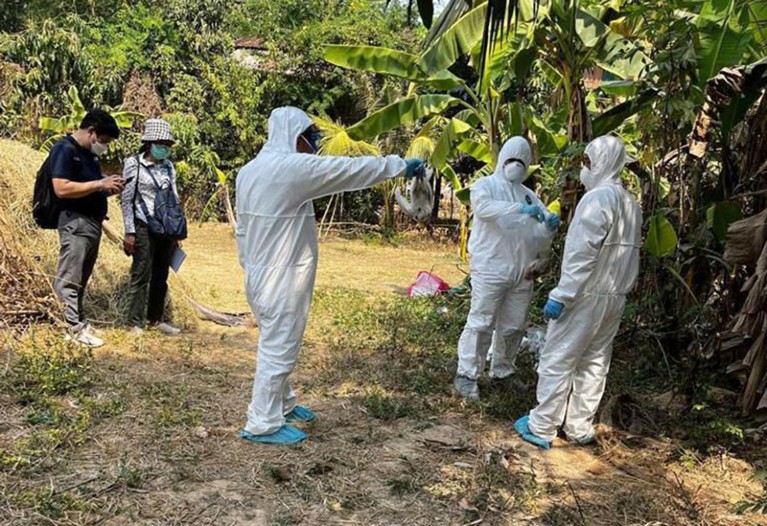The Cambodian girl who died of H5N1 this month did not have the worrisome 2.3.4.4b virus.Credit: Cambodia Ministry of Health/AP/Shutterstock
An 11-year-old girl in southern Cambodia who died last week after being infected with avian influenza A (H5N1) had a different strain than the one causing mass deaths in wild and domestic birds globally, says the scientist who led the effort to sequence viral samples from the girl. Scientists were initially concerned that the girl might have been infected with the widely circulating virus that is now spreading in some mammal species and has infected a handful of people since 2020.
Erik Karlsson, a virologist at the Pasteur Institute of Cambodia in Phnom Penh, spoke to Nature about how he and his colleagues sequenced the full genome of the virus sample from the young girl in less than a day before sharing the data on the public repository GISAID. He says the sequenced virus belongs to a group that has been found in chickens and ducks in the region for at least a decade, although the girl is the first person to be detected with H5N1 in the country in nine years.
The Cambodian Ministry of Health has swabbed 12 of her close contacts, and only her 49-year-old father has tested positive. H5N1 infections typically occur in people who have been in close contact with poultry, and so far, there is no evidence that this strain has spread between people. Investigations into how the girl was exposed to the virus are underway.
When did you receive the virus sample from the young girl?
The sample was first tested at the National Institute of Public Health in Phnom Penh, and then transferred to us. We received the sample at about 5 p.m. on 22 February, and it was sequenced within 24 hours. This really exemplifies the way that the COVID-19 pandemic has increased our capacity to sequence and share data very quickly.
The viral load in the sample was high enough that we could amplify the whole influenza genome in one go. If the viral load had been low, which is often the case, we would have had to wait about three days to grow it in cells or eggs to get enough virus to sequence. Our focus has been to get the virus sequenced and into the public domain as fast as possible.
What have you learnt from the sequence?
The virus belongs to clade 2.3.2.1c, which is an endemic strain in the region. It is the same strain that resulted in a number of infections in people in 2013 and 2014 in Cambodia, and it has been detected intermittently in poultry ever since then, including in chickens in live bird markets.
Everyone was quite concerned that the girl might have had the strain 2.3.4.4b, which is circulating around the world and causing major problems in Europe, North America and South America right now. 2.3.4.4b is a new viral clade, and we don’t know a lot about it.
Researchers have been monitoring 2.3.2.1c for quite some time, and have information on it to make reasonable judgments about its transmissibility and pathogenicity. But anytime there is a zoonotic spillover, we must treat it with the utmost importance.
What is worrisome about zoonotic spillovers?
Viruses, especially RNA viruses such as influenza, are extremely promiscuous and will quickly adapt to a new host. We’ve seen this with the virus that causes COVID-19. A spillover indicates that the virus now has a chance to adapt to a new host. That is concerning because that adaptation could result in a virus that could potentially transmit between people. Getting ahead of that, and blocking any potential for transmission, as well as understanding what the virus does in its new host, is critically important and can inform the outbreak response.
Are you also sequencing samples from the father?
We are attempting to sequence samples from the father, but he seems to have had a lower viral load, which makes it a little bit harder to rapidly get a sequence. We will try some more targeted approaches, as well as isolating the virus. But often, there isn’t enough viral load to get more than just partial sequences.
What is known about how the girl got infected?
I don’t know why the virus has spilled over from poultry to people in this case, after some ten years of it not being detected. A lot of factors still need to be investigated, but there have been a lot of global changes in agricultural practices owing to the COVID-19 pandemic that could have created the conditions for a spillover.
We know that, in Cambodia, the pandemic increased the amount of backyard poultry farming. Many people, for example tour guides, couldn’t work and had to supplement their incomes and sources of food for their families. All over the world, people are still struggling, which has resulted in changes in agricultural practices that can increase spillover risk. And changes to people’s health, for example malnutrition or being overweight, can make people more susceptible to getting infected.
Hopefully this is an isolated incident, but it could be indicative of a larger issue.
What further analysis is your team doing?
I’m hoping that we’ll get more information on the poultry samples surrounding the case soon. We can then compare those viral sequences with historical viral data, for example from live-bird-market surveillance, from those regions of Cambodia, to see whether anything major has changed, or whether something is occurring in the poultry population that is forcing the virus into, for example, more risky phenotypes, or to pose a higher risk to people.
We will also isolate and grow this virus in our biosafety-level-3 facility, which will help us to develop tools to better understand the epidemiology of this case and the virus in the region. For example, we could develop blood tests for the presence of antibodies — a marker of past infection — in samples collected from the father, other people living in the girl’s home and the broader community. The isolates will also be essential for laboratories around the world to study the virus’s transmissibility and pathogenicity, including in animal models, such as ferrets.
This interview has been edited for length and clarity.








More News
Marsupial genomes reveal how a skin membrane for gliding evolved
Galaxy found napping in the primordial Universe
Emx2 underlies the development and evolution of marsupial gliding membranes – Nature